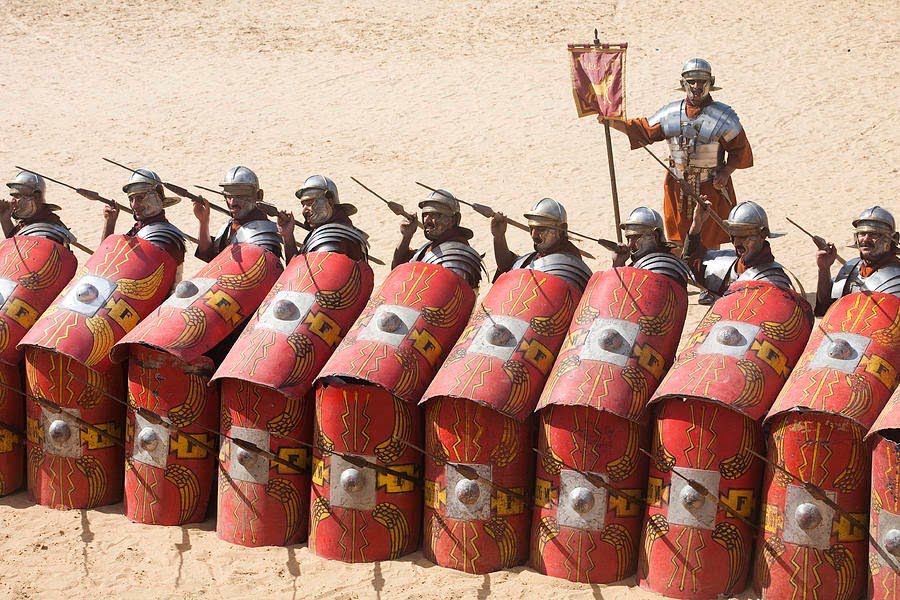The Romans remain one of the most successful armies in history. Their battle strategy remains a topic at many universities around the world. What made them so successful? Well, for starters, they would construct a fortified camp each night to provide protection from night assaults. Many of these camps (called castra), would turn into a city once a unit stayed too long.
For example, some of the cities in England, including Manchester, Lancaster, and Worchester, have a name derived from a Roman castra.
Fun fact: many of the battle and military tactics Romans used were not Roman inventions. But they managed to bring military concepts to another level. Romans were more organized and more effective.
Why were Romans successful?
Organized military tactics predate the Romans. For example, Ancient Greeks used the phalanx formation to fight, and Romans borrowed this innovation for their units of elite fights and sub-units.
The key to Roman success was their standardization of equipment and training. Every Roman soldier had to learn and understand list of commands.
![]()
With that in mind, here are some of their popular formations and military strategies.
The Triple Line
We said Romans borrowed from Ancient Greeks, and this is a perfect example. The Triple Line is basically a phalanx-style formation. Romans made formations based on military rank.
They have lines of least experienced men, the hastate, at the front of the battle. They were followed by the principles, and then the triarii, or the most experienced soldiers.
The Velites remained in the front. They were newest and poorest recruits. They had one job, and that was to attack the approaching enemy with javelins.
The lines could stretch for more than a mile. Yes, there were some gaps in the line, but it mostly presented long and unbroken front. Because of the gaps between the ranks, the rear line could step forward during battle if necessary.
The Testudo
The testudo or the tortoise is one of the most famous Roman formations. Their unique large Roman shields allowed them to present a 360-degree wall of wood to opponents.
The front rank would kneel behind their interlocked shields, and the second rank would hold their shields above the head of the men in front. The line would go on.
When they needed all-round protection, men on the flanks and the rear could also present and lock their shields together.
Romans used this strong and tight formation to approach fortifications. The soldiers could march up and not one of them would get hurt. Shields fitted closely that they formed an unbroken surface without any gaps between.
According to some historians, men could walk upon the tortoise, and even horses and chariots could drive over them, and they would not break the formation.
The only downside of this formation was speed. They walked at near tortoise-like speed. But against distant missile fire and sieges, the tortoise worked perfectly.
Medical treatment on the battlefield
One of the biggest challenges during ancient times on the battleground was medical treatment. But Romans used their structured organization to make sure soldiers get the help they need.
They had highly trained experts at their disposal who could take care of logistics and casualties. Engineers, doctors, and even architects worked together to ensure the army was physically strong.
The military had a dedicated unit of medical professionals along with a surgery unit. They treated injured soldiers on the battlefield.
And they used hot water to disinfect instruments, a technique that remained in use until the 19th century.
Fun fact: Romans also had nutritionists. Medical people had to ensure soldiers had a good diet, which is why they lived a longer life and looked stronger than their counterparts on the battlefield.
The wedge
Romans used this formation to crack open enemy units. They used legionaries to form up a triangle, with the front tip being one man. They charged towards enemy lines, and the short legionary gladius could be used as a thrusting weapon.
This formation show they had quite the knowledge in physics. It is simple physics. A sharp point drives deep into the body of enemy soldiers, while a thickening mass behind expands to further divide the enemy forces.
Best troops usually were put in the wedge. They focused on killing power against a weaker enemy. One of the most famous battles where the wedge was used was the Battle of Pydna in 168 AD.
![]()
The Carroballista
Greeks developed the core ballista mechanism in the fifth century BC. Yet, the Romans took it to another level. They increased the practical scope of the weapon on the battlefield.
The Carroballista was the most advanced two-armed torsion engine in the Roman army. A fearsome combination of ballista and the catapult, the engine could fire heavy bolts at the enemy.
The Onager
This type of catapult made use of torsional force derived from a twisted rope or springs. That is how it could generate the potential energy for the shot.
Historians describe the weapon as a scorpion. Romans used ballista to attack enemy troops, and artillery like the Onager to destroy walls and small fortifications.



